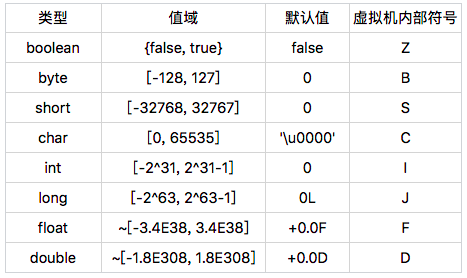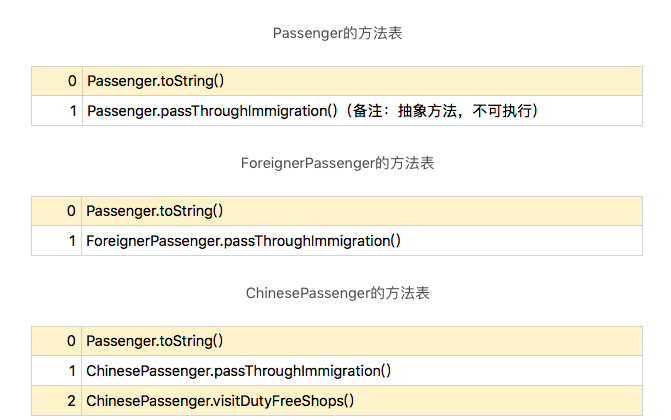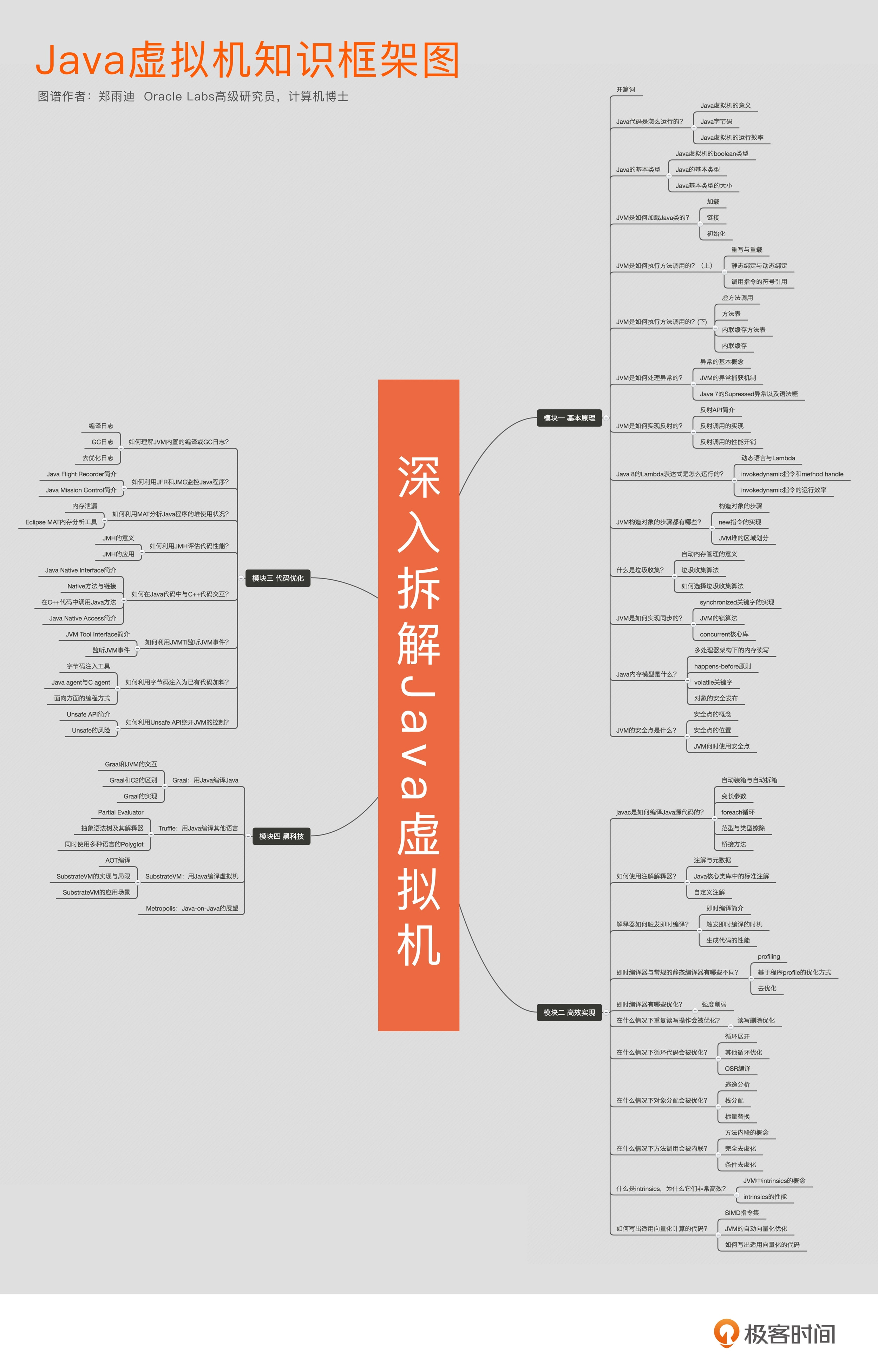晦涩难懂
Java 基本类型

Java 类加载
- 加载 - load class files to JVM
- 链接
- 验证 - validation (spec, constraint)
- 准备 - allocate memory for static member (property), bind virtual table
- 解析 - resolve tokens to actual references
- 初始化
<clinit>
- 当虚拟机启动时,初始化用户指定的主类;
- 当遇到用以新建目标类实例的 new 指令时,初始化 new 指令的目标类;
- 当遇到调用静态方法的指令时,初始化该静态方法所在的类;
- 当遇到访问静态字段的指令时,初始化该静态字段所在的类;
- 子类的初始化会触发父类的初始化;
- 如果一个接口定义了 default 方法,那么直接实现或者间接实现该接口的类的初始化,会触发该接口的初始化;
- 使用反射 API 对某个类进行反射调用时,初始化这个类;
- 当初次调用
MethodHandle 实例时,初始化该 MethodHandle 指向的方法所在的类。
新建数组只会加载类,getInstance 时才会链接、初始化。var obj = new MyClazz[2];
1
2
3
4
5
6
7
8
9
10
11
|
// 只有当调用 Singleton.getInstance 时,程序才会访问 LazyHolder.INSTANCE,才会触发对 LazyHolder 的初始化(对应第 4 种情况),继而新建一个 Singleton 的实例。
// 由于类初始化是线程安全的,并且仅被执行一次,因此程序可以确保多线程环境下有且仅有一个 Singleton 实例。
public class Singleton {
private Singleton() {}
private static class LazyHolder {
static final Singleton INSTANCE = new Singleton();
}
public static Singleton getInstance() {
return LazyHolder.INSTANCE;
}
}
|
方法执行
字节码调用指令
invokestatic 调用静态方法invokespecial 调用私有实例方法、构造器,使用 super 关键字调用父类的实例方法或构造器,所实现接口的默认方法invokevirtual 调用非私有实例方法invokeinterface 调用接口方法invokedynamic 调用动态方法
1
2
3
4
5
6
7
8
9
10
11
12
13
14
15
16
17
18
19
20
21
22
23
24
25
26
|
interface Client {
boolean isVIP();
}
class Store {
public double calc(double originPrice, Client c) {
return originPrice * 0.8d;
}
}
class AnotherStore extends Store {
@Override
public double calc(double originPrice, Client c) {
if (c.isVIP()) { // invokeinterface
return originPrice * vip(); // invokestatic
} else {
return super.calc(originPrice, c); // invokespecial
}
}
public static double vip() {
return new Random() // invokespecial
.nextDouble() // invokevirtual
+ 0.8d;
}
}
|
在编译过程中,Compiler 并不知道目标方法的具体内存地址。因此,Java 编译器会暂时用符号引用来表示该目标方法。这一符号引用包括目标方法所在的类或接口的名字,以及目标方法的方法名和方法描述符。符号引用存储在 class 文件的常量池中。
1
2
3
4
5
|
$javap -V Store.class
Constant pool:
#16 = InterfaceMethodref #27.#29 // Client.isVIP:()Z
...
#22 = Methodref #1.#33. // AnotherStore.vip:()D
|
Java 里所有非私有实例方法调用都会被编译成 invokevirtual 指令,而接口方法调用都会被编译成 invokeinterface 指令。这两种指令,均属于 Java 虚拟机中的虚方法调用。
在绝大多数情况下,Java 虚拟机需要根据调用者的动态类型,来确定虚方法调用的目标方法。这个过程我们称之为动态绑定。
Java 虚拟机中采取了一种用空间换取时间的策略来实现动态绑定。它为每个类生成一张方法表,用以快速定位目标方法。
方法表
方法表本质上是一个数组,每个数组元素指向一个当前类及其祖先类中非私有的实例方法。
- invokevirtual - virtual method table (vtable)
- invokeinterface - interface method table (itable)

使用了方法表的动态绑定与静态绑定相比,仅仅多出几个内存解引用操作:访问栈上的调用者,读取调用者的动态类型,读取该类型的方法表,读取方法表中某个索引值所对应的目标方法。
异常
在编译生成的字节码中,每个方法都附带一个异常表。异常表中的每一个条目代表一个异常处理器,并且由 from 指针、to 指针、target 指针以及所捕获的异常类型构成。这些指针的值是字节
码索引(bytecode index,bci),用以定位字节码。
当程序触发异常时,Java 虚拟机将查找异常表,并依此决定需要将控制流转移至哪个异常处理器之中。Java 代码中的 catch 代码块和 finally 代码块都会生成异常表条目。
1
2
3
4
5
6
7
8
9
10
11
12
13
14
15
16
17
18
19
|
public static void main(String[] args) {
try {
mayThrowException();
} catch (Exception e) {
e.printStackTrace();
}
}
// 对应的 Java 字节码
public static void main(java.lang.String[]);
Code:
0: invokestatic mayThrowException:()V
3: goto 11
6: astore_1
7: aload_1
8: invokevirtual java.lang.Exception.printStackTrace
11: return
Exception table:
from to target type
0 3 6 Class java/lang/Exception // 异常表条目
|
1
2
3
4
5
6
7
8
9
10
11
12
13
14
15
16
17
18
19
20
21
22
23
24
25
26
27
|
// 编译并用 javap -c 查看编译后的字节码
public class Foo {
private int tryBlock;
private int catchBlock;
private int finallyBlock;
private int methodExit;
public void test() {
for (int i = 0; i < 100; i++) {
try {
tryBlock = 0;
if (i < 50) {
continue;
} else if (i < 80) {
break;
} else {
return;
}
} catch (Exception e) {
catchBlock = 1;
} finally {
finallyBlock = 2;
}
}
methodExit = 3;
}
}
|
反射
Method.invoke -> MethodAccessor
NativeMethodAccessorImpl 本地实现GeneratedMethodAccessorN 动态生成实现 -Dsun.reflect.noInflation=true 取消委派实现
1
2
3
4
5
6
7
8
9
10
11
12
13
14
15
16
17
18
19
20
|
class Test {
public static void target(int i) {
new Exception("#"+i).printStackTrace();
}
}
public static void main(String[] args) throws Exception {
Class<?> klass = Class.forName("Test");
Method method = klass.getMethod("target", int.class);
method.invoke(null, 0);
}
# 不同版本的输出略有不同,这里我使用了 Java 10
$ java Test
java.lang.Exception: #0
at Test.target(Test.java:5)
at java.base/jdk.internal.reflect.NativeMethodAccessorImpl .invoke0(Native Method)
at java.base/jdk.internal.reflect.NativeMethodAccessorImpl. .invoke(NativeMethodAccessorImpl.java:62)
at java.base/jdk.internal.reflect.DelegatingMethodAccessorImpl.i .invoke(DelegatingMethodAccessorImpl.java:43)
at java.base/java.lang.reflect.Method.invoke(Method.java:564)
Test.main(Test.java:131
|
方法句柄
方法句柄是一个强类型的、能够被直接执行的引用。它仅关心所指向方法的参数类型以及返回类型,而不关心方法所在的类以及方法名。方法句柄的权限检查发生在创建过程中,相较于反射调用节省了调用时反复权限检查的开销。
1
2
3
4
5
6
7
8
9
|
class Foo {
public void bae(Object o) {}
public static void main(String[] args) throws Throwable {
MethodHandles.Lookup l = MethodHandles.lookup();
MethodType t = MethodType.methodType(void.class, Object.class);
MethodHandle mh = l.findVirtual(Foo.class, "bar", t);
mh.invokeExact(new Foo(), new Object());
}
}
|
内存分布
通过 new 指令新建出来的对象,它的内存其实涵盖了所有父类中的实例字段。也就是说,虽然子类无法访问父类的私有实例字段,或者子类的实例字段隐藏了父类的同名实例字段,但是子类的实例还是会为这些父类实例字段分配内存的。
Padding/@Contened -> false sharing
垃圾回收
GCROOT
- Java 方法栈桢中的局部变量;
- 已加载类的静态变量;
- JNI handles;
- 已启动且未停止的 Java 线程。
Java 虚拟机中的 Stop-the-world 是通过安全点(safepoint)机制来实现的。当 Java 虚拟机收到 Stop-the-world 请求,它便会等待所有的线程都到达安全点,才允许请求 Stop-the-world 的线程进行独占的工作。
JMM
Happens Before relationship
- 解锁操作 happens-before 之后(这里指时钟顺序先后)对同一把锁的加锁操作。
- volatile 字段的写操作 happens-before 之后(这里指时钟顺序先后)对同一字段的读操作。
- 线程的启动操作(即 Thread.starts()) happens-before 该线程的第一个操作。
- 线程的最后一个操作 happens-before 它的终止事件(即其他线程通过 Thread.isAlive() 或 Thread.join() 判断该线程是否中止)。
- 线程对其他线程的中断操作 happens-before 被中断线程所收到的中断事件(即被中断线程的 InterruptedException 异常,或者第三个线程针对被中断线程的 Thread.interrupted 或者 Thread.isInterrupted 调用)。
- 构造器中的最后一个操作 happens-before 析构器的第一个操作。
对于 JIT 来说,它会针对前面提到的每一个 happens-before 关系,向正在编译的目标方法中插入相应的读读、读写、写读以及写写内存屏障。
读写屏障, 类似于检查点, 在读写前验证当前内存数据的状态 (是否处于 valid 状态, 是否被其他 CPU mark 为 dirty)
synchronzied
关于 monitorenter 和 monitorexit 的作用,我们可以抽象地理解为每个锁对象拥有一个锁计数器和一个指向持有该锁的线程的指针。(ReentrantLock)
重量级锁会阻塞、唤醒请求加锁的线程。它针对的是多个线程同时竞争同一把锁的情况。Java 虚拟机采取了自适应自旋,来避免线程在面对非常小的 synchronized 代码块时,仍会被阻塞、唤醒的情况。
轻量级锁采用 CAS 操作,将锁对象的标记字段替换为一个指针,指向当前线程栈上的一块空间,存储着锁对象原本的标记字段。它针对的是多个线程在不同时间段申请同一把锁的情况。
偏向锁只会在第一次请求时采用 CAS 操作,在锁对象的标记字段中记录下当前线程的地址。在之后的运行过程中,持有该偏向锁的线程的加锁操作将直接返回。它针对的是锁仅会被同一线程持有的情况。
compliation
从 Java 8 开始,Java 虚拟机默认采用分层编译的方式。它将执行分为五个层次,分为为 0 层解释执行,1 层执行没有 profiling 的 C1 代码,2 层执行部分 profiling 的 C1 代码,3 层执行全部 profiling 的 C1 代码,和 4 层执行 C2 代码。(C1 client, C2 server)
通常情况下,方法会首先被解释执行,然后被 3 层的 C1 编译,最后被 4 层的 C2 编译。
即时编译是由方法调用计数器和循环回边计数器触发的。在使用分层编译的情况下,触发编译的阈值是根据当前待编译的方法数目动态调整的。
OSR 是一种能够在非方法入口处进行解释执行和编译后代码之间切换的技术。OSR 编译可以用来解决单次调用方法包含热循环的性能优化问题。(on stack replacement)
常用工具
- javap - 查看 Java 字节码
javac Foo.javajavap -p -v Foo
- class info
- constant pool
- property area
- function
1
2
3
4
5
6
7
8
9
10
11
12
13
14
15
16
17
|
public class Foo {
private int tryBlock;
private int catchBlock;
private int finallyBlock;
private int methodExit;
public void test() {
try {
tryBlock = 0;
} catch (Exception e) {
catchBlock = 1;
} finally {
finallyBlock = 2;
}
methodExit = 3;
}
}
|
bytecode
1
2
3
4
5
6
7
8
9
10
11
12
13
14
15
16
17
18
19
20
21
22
23
24
25
26
27
28
29
30
31
32
33
34
35
36
37
38
39
40
41
42
43
44
45
46
47
48
49
50
51
52
53
54
55
56
57
58
59
60
61
62
63
64
65
66
67
68
69
70
71
72
73
74
75
76
77
78
79
80
81
82
83
84
85
86
87
88
89
90
91
92
93
94
95
96
97
98
99
100
101
102
103
104
105
106
107
108
109
110
111
112
113
114
115
116
117
118
119
120
121
122
123
124
125
126
|
Classfile ../Foo.class
Last modified ..; size 541 bytes
MD5 checksum 3828cdfbba56fea1da6c8d94fd13b20d
Compiled from "Foo.java"
public class Foo
minor version: 0
major version: 54
flags: (0x0021) ACC_PUBLIC, ACC_SUPER
this_class: #7 // Foo
super_class: #8 // java/lang/Object
interfaces: 0, fields: 4, methods: 2, attributes: 1
Constant pool:
#1 = Methodref #8.#23 // java/lang/Object."<init>":()V
#2 = Fieldref #7.#24 // Foo.tryBlock:I
#3 = Fieldref #7.#25 // Foo.finallyBlock:I
#4 = Class #26 // java/lang/Exception
#5 = Fieldref #7.#27 // Foo.catchBlock:I
#6 = Fieldref #7.#28 // Foo.methodExit:I
#7 = Class #29 // Foo
#8 = Class #30 // java/lang/Object
#9 = Utf8 tryBlock
#10 = Utf8 I
#11 = Utf8 catchBlock
#12 = Utf8 finallyBlock
#13 = Utf8 methodExit
#14 = Utf8 <init>
#15 = Utf8 ()V
#16 = Utf8 Code
#17 = Utf8 LineNumberTable
#18 = Utf8 test
#19 = Utf8 StackMapTable
#20 = Class #31 // java/lang/Throwable
#21 = Utf8 SourceFile
#22 = Utf8 Foo.java
#23 = NameAndType #14:#15 // "<init>":()V
#24 = NameAndType #9:#10 // tryBlock:I
#25 = NameAndType #12:#10 // finallyBlock:I
#26 = Utf8 java/lang/Exception
#27 = NameAndType #11:#10 // catchBlock:I
#28 = NameAndType #13:#10 // methodExit:I
#29 = Utf8 Foo
#30 = Utf8 java/lang/Object
#31 = Utf8 java/lang/Throwable
{
private int tryBlock;
descriptor: I
flags: (0x0002) ACC_PRIVATE
private int catchBlock;
descriptor: I
flags: (0x0002) ACC_PRIVATE
private int finallyBlock;
descriptor: I
flags: (0x0002) ACC_PRIVATE
private int methodExit;
descriptor: I
flags: (0x0002) ACC_PRIVATE
public Foo();
descriptor: ()V
flags: (0x0001) ACC_PUBLIC
Code:
stack=1, locals=1, args_size=1
0: aload_0
1: invokespecial #1 // Method java/lang/Object."<init>":()V
4: return
LineNumberTable:
line 1: 0
public void test();
descriptor: ()V
flags: (0x0001) ACC_PUBLIC
Code:
stack=2, locals=3, args_size=1
0: aload_0
1: iconst_0
2: putfield #2 // Field tryBlock:I
5: aload_0
6: iconst_2
7: putfield #3 // Field finallyBlock:I
10: goto 35
13: astore_1
14: aload_0
15: iconst_1
16: putfield #5 // Field catchBlock:I
19: aload_0
20: iconst_2
21: putfield #3 // Field finallyBlock:I
24: goto 35
27: astore_2
28: aload_0
29: iconst_2
30: putfield #3 // Field finallyBlock:I
33: aload_2
34: athrow
35: aload_0
36: iconst_3
37: putfield #6 // Field methodExit:I
40: return
Exception table:
from to target type
0 5 13 Class java/lang/Exception
0 5 27 any
13 19 27 any
LineNumberTable:
line 9: 0
line 13: 5
line 14: 10
line 10: 13
line 11: 14
line 13: 19
line 14: 24
line 13: 27
line 14: 33
line 15: 35
line 16: 40
StackMapTable: number_of_entries = 3
frame_type = 77 /* same_locals_1_stack_item */
stack = [ class java/lang/Exception ]
frame_type = 77 /* same_locals_1_stack_item */
stack = [ class java/lang/Throwable ]
frame_type = 7 /* same */
}
SourceFile: "Foo.java"
|
Framework

References


